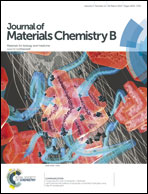Combination of surface imprinting and immobilized template techniques for preparation of core–shell molecularly imprinted polymers based on directly amino-modified Fe3O4 nanoparticles for specific recognition of bovine hemoglobin†
Abstract
In this work, the core–shell bovine hemoglobin (BHb)-imprinted superparamagnetic nanoparticles (Fe3O4@BHb-MIPs) were synthesized by combining for the first time a surface imprinting technique and a two-step immobilized template strategy. Initially, amino-functionalized Fe3O4 nanoparticles (Fe3O4@NH2) were synthesized directly through a facile one-pot hydrothermal method. Next, BHb was immobilized on the surface of Fe3O4@NH2 through non-covalent interactions. Then, siloxane co-polymerization on the Fe3O4@NH2–protein complex surface resulted in a polymeric network molded around BHb which then became further immobilized. Finally, a thin polymer layer with specific recognition cavities for BHb was formed on the surface of Fe3O4@NH2 after the removal of the template protein. The morphology and structure property of the prepared magnetic nanoparticles were characterized by transmission electronic microscopy (TEM), Fourier transform infrared spectroscopy (FT-IR), X-ray diffractometer (XRD), and vibrating sample magnetometer (VSM). To obtain the best selectivity and binding performance, the polymerization and adsorption conditions were investigated in detail. Under the optimized conditions, the Fe3O4@BHb-MIPs exhibited fast adsorption kinetics, large binding capacity, significant selectivity, and favorable reproducibility. The resultant Fe3O4@BHb-MIPs could not only specifically extract BHb from a mixed standard protein mixture, but also selectively enriched BHb from a real bovine blood sample. In addition, the synthetic process was quite simple and the stability and regeneration of the Fe3O4@BHb-MIPs were also satisfactory.


 Please wait while we load your content...
Please wait while we load your content...